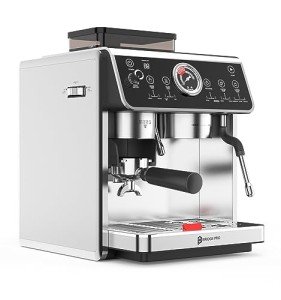Heat Exchange Espresso Machines: A Comprehensive Guide
Espresso machines have progressed considerably over the years, dealing with the requirements of home baristas and coffee professionals alike. Amongst these machines, heat exchange espresso machines have actually acquired popularity due to their capability to provide consistent performance and exceptional brew quality. In this article, we will check out the functions, benefits, and essential features of heat exchange espresso machines, supplying an extensive understanding for both possible purchasers and coffee enthusiasts.
Comprehending Heat Exchange Technology
Heat exchange espresso machines run on a distinct principle that enables synchronised water heating for developing and steaming. They are geared up with a single boiler that uses a heat exchanger system. Steam Espresso Machines is significant as it enables users to brew espresso while steaming milk simultaneously, promoting effectiveness in the coffee-making process.
How Does a Heat Exchange Espresso Machine Work?
The procedure starts with the machine's water inlet filling the boiler. As the water warms up, it turns to steam. The ingenious heat exchanger uses hot steam to heat additional water in a separate passage developed specifically for the brew group. This implies that water can reach the perfect brewing temperature level without awaiting the boiler to change. The essential steps include:
- Water Fill: Water is drawn into the boiler.
- Heating Process: The boiler warms up as water is converted into steam.
- Heat Exchange: Steam heats up water in the heat exchanger tube.
- Brewing: Water from the heat exchanger is pressed through coffee grounds, drawing out the flavors required for a rich espresso.
This process enables quick temperature adjustments and enhanced coffee extraction.
Benefits of Heat Exchange Espresso Machines
Heat exchange espresso machines provide a number of benefits, especially for those seeking to optimize their coffee experience. Here are some essential advantages:
- Simultaneous Brewing and Steaming: Users can brew espresso while steaming milk, making it perfect for hectic coffee shops and home baristas who value performance.
- Temperature Stability: The boiler's steam pressure assists keep a steady temperature, which is vital for constant espresso extraction.
- Versatility: The design permits fast changing between brewing and steaming, making it easier to create various coffee drinks, from lattes to coffees.
- Easy to use: Models often feature accessible controls, making it feasible for both newbies and knowledgeable baristas to produce quality beverages.
- Professional Quality: Heat exchange machines are frequently utilized in commercial settings, supplying users with high-quality brewing efficiency in your home.
Secret Features to Look for in Heat Exchange Espresso Machines
When considering the purchase of a heat exchange espresso machine, there are numerous functions that a person need to take into consideration:
- Build Quality: Look for machines made from durable materials, such as stainless steel or brass, making sure durability.
- Boiler Size: A larger boiler will hold more water and sustain higher output over time.
- PID Temperature Control: This feature assists maintain constant brew temperatures, which can boost the coffee-making process.
- Group Head Design: Machines with a saturated or semi-saturated group head offer much better temperature stability.
- Ease of Use: User-friendly user interfaces and instinctive controls improve the total experience for baristas at all skill levels.
- Steam Wand Quality: A good steam wand with correct insulation and flexibility enables better texturing of milk.
- Water Reservoir Size: Depending on your needs, think about how typically you want to fill up the water reservoir.
Comparison of Popular Heat Exchange Espresso Machines
To much better understand the alternatives offered in the market, below is a contrast table of some popular heat exchange espresso machines:
| Machine Model | Boiler Size | PID Control | Rate Range | User Ratings |
|---|---|---|---|---|
| Profitec Pro 700 | 2.0 L | Yes | ₤ 2,000-₤ 2,500 | 9.5/ 10 |
| Rocket Espresso R58 | 1.8 L | Yes | ₤ 2,400-₤ 2,800 | 9.4/ 10 |
| Elekta Bianca | 1.8 L | Yes | ₤ 2,500-₤ 3,000 | 9.6/ 10 |
| La Spaziale S1 Vivaldi II | 1.5 L | Yes | ₤ 1,800-₤ 2,200 | 9.2/ 10 |
| Bezzera Magica | 1.2 L | No | ₤ 1,600-₤ 1,800 | 9.0/ 10 |
FAQs About Heat Exchange Espresso Machines
What is the primary difference in between a heat exchange and a dual boiler espresso machine?
While both types can brew espresso and steam milk at the same time, dual boiler machines have separate boilers for brewing and steaming. In contrast, heat exchange machines utilize a single boiler and a heat exchanger to attain the exact same function.
Are heat exchange machines suitable for novices?
Yes! Many heat exchange machines are designed with user-friendly features, making them accessible for novices. With appropriate guidance and practice, users can quickly produce quality espresso.
What type of upkeep do heat exchange espresso machines need?
Routine maintenance consists of descaling, cleaning up the boiler, examining seals and gaskets, and keeping the group head tidy. Latte Machines guarantees durability and constant efficiency.
Can I use a heat exchange machine for various kinds of coffee beverages?
Definitely! Heat exchange machines allow users to create a range of coffee beverages, consisting of espresso, lattes, cappuccinos, and more.
Heat exchange espresso machines represent a mix of development and tradition, providing coffee enthusiasts with the tools needed for crafting the ideal cup. Their ability to simultaneously brew and steam, integrated with precise temperature level control, makes them a compelling choice for both home baristas and specialists. With the right knowledge on functions and maintenance, users can open a world of charming coffee experiences, ensuring that each sip is as delightful as the last.

